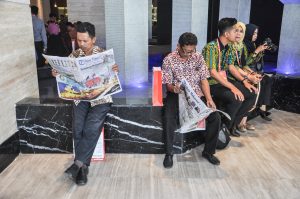Last week, to coincide with World Press Freedom Day, the watchdog group Reporters Without Borders (RSF) released its annual global press freedom index, which rates the media freedom of 180 nations and territories along several axes.
Like the past few iterations of the report, this year’s World Press Freedom Index made for some dispiriting reading.
In its introduction to the index, RSF wrote that “press freedom around the world is being threatened by the very people who should be its guarantors – political authorities.” It noted “a worrying decline in support and respect for media autonomy and an increase in pressure from the state or other political actors.”
This trend is very much reflected in Southeast Asia, a dreary spot within a dim Asia-Pacific region, where 26 of the 32 countries and territories saw their scores fall from last year’s index. RSF found that the press situation was “very serious” in four Southeast Asian nations, and “difficult” in five others. Just two – Timor-Leste and Thailand – ranked any higher.
Two Southeast Asian nations bucked the downward regional trend: Thailand, which rose to 87th position, up from 106 in last year’s survey; and Brunei, which rose from 142nd place to 117th. However, the situation in neither nation remains particularly hospitable to the independent media.
While last year’s general election in Thailand saw the opposition Pheu Thai Party form a new government, the structural impediments to press freedom remain considerable: most of the press is in the hands of prominent oligarchs, while defamation and cybercrime laws are also “systematically used to harass journalists.”
Meanwhile, the country’s lese-majeste law, which protects the monarchy, one of the country’s most powerful institutions, from scrutiny or criticism, “is a permanent threat hanging over every media outlet.”
In oil-rich Brunei, meanwhile, “press freedom is virtually non-existent,” RSF wrote, with the media owned by the state or members of Sultan Hassanal Bolkiah’s family and strict media restrictions in place.
The situation for media freedom in the four other mainland Southeast Asian states – Vietnam, Myanmar, Cambodia, and Laos – was not significantly different from last year – which is to say, dire. Vietnam remained the country with the least freedom for the press in the region, ranking 174th out of 180. While this marked an incremental improvement from the 178th position it occupied in last year’s survey, RSF presented a picture of a stifling media landscape, in which most publications are under close state control and 35 media workers are confirmed to be in state custody. There are “many topics” that are subject to state censorship, including “political dissidents, cases of corruption involving senior officials, the single party’s legitimacy, relations with China and, of course, human rights issues.”
Things also remained desperate for the press in Myanmar (171st position), where the 2021 coup “obliterated the fragile progress towards greater press freedom” and prompted most independent media outlets to operate from exile. According to RSF, the military junta is holding 62 journalists and media workers in custody. The next spots were filled by Laos (153rd), which due to press controls is an “information ‘black hole’ from which little reliable information emerges,” and Cambodia (151st), where former Prime Minister Hun Sen’s “sad legacy of repression against independent media seems to be perpetuated by his son, Hun Manet,” who took office last year.
Of the remaining Southeast Asian nations, Malaysia saw the most significant slide in the rankings, falling from 73rd place in last year’s ranking to 107th this year. RSF did not explicitly state the reason for this slide, though it is notable that it took place in the first complete calendar year under Prime Minister Anwar Ibrahim, who despite his reformist vibes, has used the power of the state to quash discussion of sensitive and socially destabilizing subjects touching on the so-called “3Rs”: race, royalty, and religion. As RSF noted, “government exerts a great deal of political pressure to deter the media from tackling sensitive subjects or from criticizing politicians and government officials.”
A similar situation pertains in Indonesia (111th), where outgoing president Joko Widodo, also touted a reformist upon coming to office in 2014, has made “a series of broken promises as regards press freedom.”
Singapore (126th), meanwhile, boasts of being a model for economic development, but “it is an example of what not to be in regard to freedom of the press.” According to RSF, the country’s citizens “have to deal with a media machine that is tightly controlled by the government. Facing many challenges, independent media outlets reporting on political and social issues are thus few and far between.” The least free media outlet in maritime Southeast Asia was the Philippines (134th), which is simultaneously one of the region’s most dynamic media environments and one of the most dangerous nations in which to be a journalist.
As in past years, the region’s bright spot is its youngest nation, Timor-Leste. While the nation fell from 10th position in last year’s index to 20th position this year, “journalists are usually free to report the news and are rarely the targets of harassment or physical attacks” and “no journalist has ever been jailed in connection with their work.”

































